Trane RT-PRC007-EN User Manual
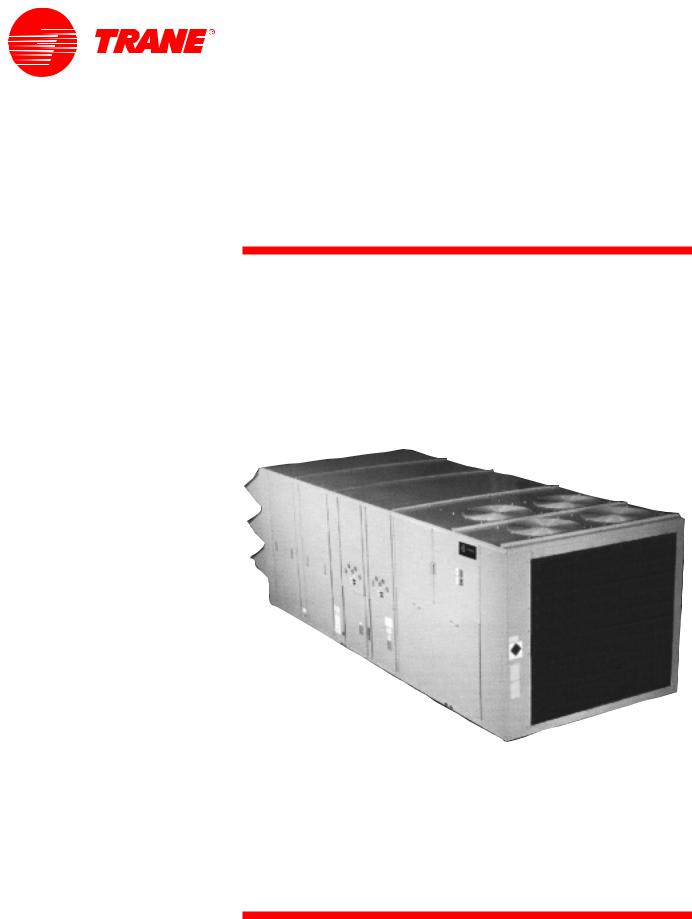
Packaged Rooftop
Air Conditioners
27 ½ to 50Ton - 60 Hz Voyager™ Commercial
October 2001 |
RT-PRC007-EN |

Introduction
Packaged Rooftop
Air Conditioners
Through the years,Trane has designed and developed the most complete line of Packaged Rooftop products available in the market today.Trane was the first to introduce the Micro —microelectronic unit controls— and again moved ahead with the introduction of theVoyager Commercial products.
TheVoyager Commercial line offers 27½ to 50 ton models; five sizes to meet the changing demands of the commercial rooftop market.
Our customers demand thatTrane products provide exceptional reliability, meet stringent performance requirements, and to be competitively priced. Trane delivers withVoyager Commercial.
Voyager Commercial features cutting edge technologies like the reliable 3-D® Scroll compressors,Trane engineered microprocessor controls, computeraided run testing, and Integrated Comfort™ Systems. So, whether you’re the contractor, the engineer, or the owner you can be certainVoyager Commercial Products are built to meet your needs.
It’s HardTo Stop ATrane®.
©American Standard Inc. 2001 |
RT-PRC007-EN |
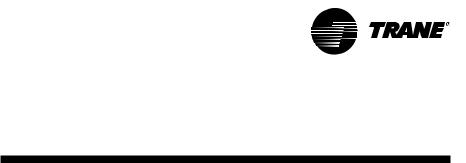
Contents
Introduction |
2 |
Features and Benefits |
|
4 |
|
Application Considerations |
|
10 |
|
Selection Procedure |
|
12 |
|
Model Number Description |
|
14 |
|
General Data |
15 |
Performance Data |
|
19 |
|
Performance Adjustment Factors |
|
18 |
|
Controls |
28 |
Electric Power |
|
32 |
|
Dimension andWeights |
|
|
|
34 |
|
Mechanical Specifications |
|
|
|
41 |
|
|
|
RT-PRC007-EN |
3 |
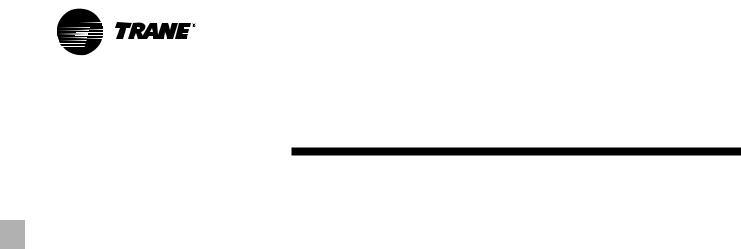
Features and
Benefits
Standard Features
•Factory installed and commissioned microelectronic controls
•Trane 3-D™ Scroll Compressors
•Dedicated downflow or horizontal configuration
•CV orVAV control
•FROSTAT™ coil frost protection on all units
•Supply air overpressurization protection onVAV units
•Supply airflow proving
•Emergency stop input
•Compressor lead-lag
•Occupied-Unoccupied switching
•Timed override activation
•FC supply fans
•UL and CSA listing on standard options
•Two inch standard efficiency filters
•Finish exceeds salt spray requirements of ASTM B117
•Sloped condensate drain pan
Optional Features
•Electric heat
•Natural gas heat
•LP gas heat (kit only)
•Power Exhaust
•Barometric Relief
•High Efficiency 2”Throwaway Filters
•High Efficiency 4”Throwaway Filters
•High Efficiency supply fan motors
•Manual fresh air damper
•Economizer with dry bulb control
•Economizer with reference enthalpy control
•Economizer with differential (comparative) enthalpy control
•Inlet guide vanes onVAV units
•Variable frequency drives onVAV units (with or without bypass)
•ServiceValves
•Through-the-base electrical provision
•Factory mounted disconnect with external handle (non-fused)
•Factory powered 15A GFI convenience outlet
•Field powered 15A GFI convenience outlet
•Integrated Comfort™ System Control Option
•Ventilation Override
•Hinged Service Access
•Factory installed condenser coil guards
•Black epoxy coated condenser coil
•Sloped stainless steel evaporator coil drain pans
4 |
RT-PRC007-EN |
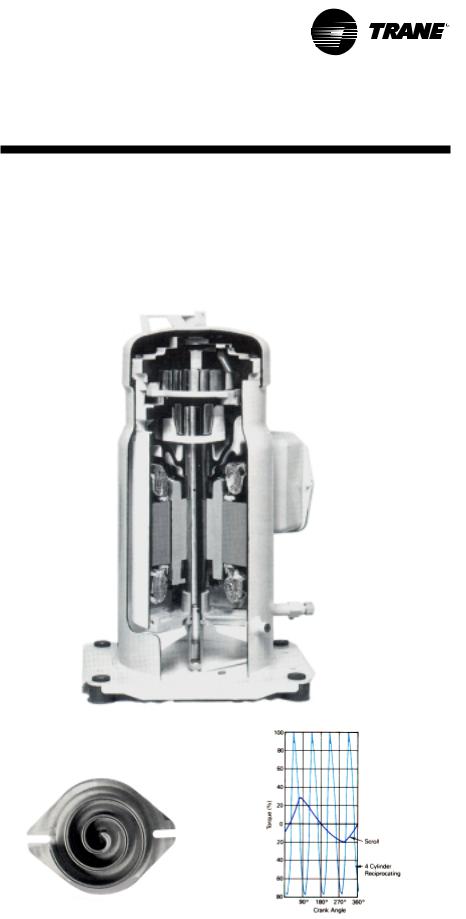
Features and
Benefits
Trane 3-D® Scroll Compressor
Simple Design with 70% Fewer Parts
Fewer parts than an equal capacity reciprocating compressor means significant reliability and efficiency benefits.The single orbiting scroll eliminates the need for pistons, connecting rods, wrist pins and valves. Fewer parts lead to increased reliability. Fewer moving parts, less rotating mass and less internal friction means greater efficiency than reciprocating compressors.
TheTrane 3-D Scroll provides important reliability and efficiency benefits.The 3-D Scroll allows the orbiting scrolls to touch in all three dimensions, forming a completely enclosed compression chamber which leads to increased efficiency. In addition, the orbiting scrolls only touch with enough force to create a seal; there is no wear between the scroll plates.The fixed and orbiting scrolls are made of high strength cast iron which results in less thermal distortion, less leakage, and higher efficiencies. The most outstanding feature of the 3-D Scroll compressor is that slugging will not cause failure. In a reciprocating compressor, however, the liquid or dirt can cause serious damage.
LowTorque Variation
The 3-D Scroll compressor has a very smooth compression cycle; torque variations are only 30 percent of that produced by a reciprocating compressor. This means that the scroll compressor imposes very little stress on the motor resulting in greater reliability. Low torque variation reduces noise and vibration.
Suction Gas Cooled Motor
Compressor motor efficiency and reliability is further optimized with the latest scroll design. Cool suction gas keeps the motor cooler for longer life and better efficiency.
Proven DesignThroughTesting and
Research
With over twenty years of development and testing,Trane 3-D Scroll compressors have undergone more
One of two matched scroll plates — the distinguishing feature of the scroll compressor.
than 400,000 hours of laboratory testing and field operation.This work combined with over 25 patents makesTrane the worldwide leader in air conditioning scroll compressor technology.
Chart illustrates low torque variation of 3-D Scroll compressor vs reciprocating compressor.
RT-PRC007-EN |
5 |

Features and
Benefits
Quality and Reliability
Forced Combustion Blower
Negative Pressure GasValve
Hot Surface Ignitor
Drum andTube Heat Exchanger
Micro Controls
The Micro provides unit control for heating, cooling and ventilating utilizing input from sensors that measure outdoor and indoor temperature.
Quality and Reliability are enhanced through the use of time-tested microprocessor controls and logic.
The Micro:
•prevents the unit from short cycling, considerably improving compressor life.
•ensures that the compressor will run for a specific amount of time which allows oil to return for better lubrication, enhancing the reliability of the commercial compressor.
TheVoyager with the Micro reduces the number of components required to operate the unit, thereby reducing possibilities for component failure.
Drum andTube Heat Exchanger
The drum and tube heat exchanger is designed for increased efficiency and reliability and has utilized improved technology incorporated in the large roof top commercial units for almost
20 years.
The heat exchanger is manufactured using aluminized steel with stainless steel components for maximum durability.The requirement for cycle testing of heat exchangers is 10,000 cycles by ANSI Z21.47.This is the standard required by both UL and AGA for cycle test requirements.Trane requires the design to be tested to 21/2 times this current standard.The drum and tube design has been tested and passed over 150,000 cycles which is over 15 times the current ANSI cycling requirements.
The negative pressure gas valve will not allow gas flow unless the combustion blower is operating.This is one of our unique safety features.
The forced combustion blower supplies pre-mixed fuel through a single stainless steel burner screen into a sealed drum where ignition takes place. It is more reliable to operate and maintain than a multiple burner system.
The hot surface ignitor is a gas ignition device which doubles as a safety device utilizing a continuous test to prove the flame.The design is cycle tested at the factory for quality and reliability.
All the gas/electric rooftops exceed all California seasonal efficiency requirements.They also perform better than required to meet the California NOx emission requirements.
6 |
RT-PRC007-EN |
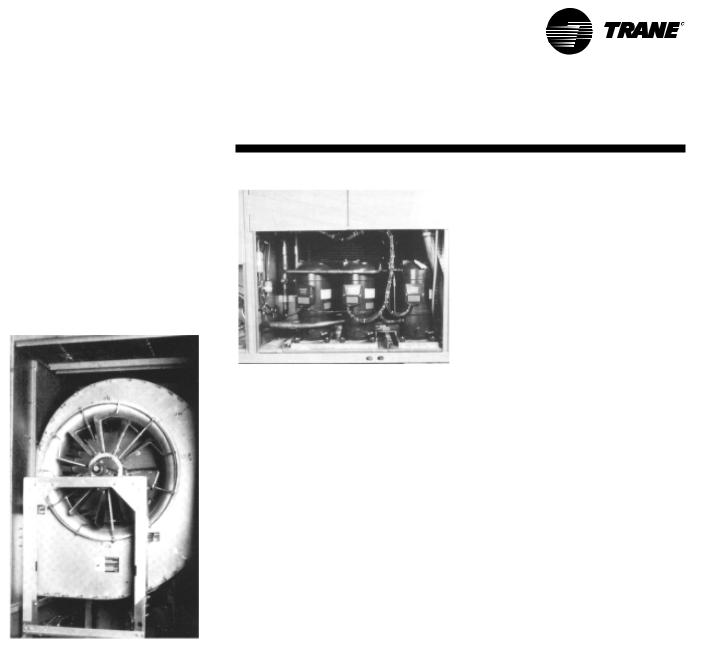
Features and
Benefits
FC Fans with Inlet GuideVanes
Trane’s forward-curved fans with inlet guide vanes pre-rotate the air in the direction of the fan wheel, decreasing static pressure and horsepower, essentially unloading the fan wheel.The unloading characteristics of aTrane FC fan with inlet guide vanes result in superior part load performance.
Excellent Part-Load Efficiency
The Scroll compressor’s unique design allows it to be applied in a passive parallel manifolded piping scheme, something that a “recip” just doesn’t do very well.
When the unit begins stage back at part load it still has the full area and circuitry of its evaporator and condenser coils available to transfer heat. In simple terms this means superior part-load efficiencies (IPLV) and lower unit operating costs.
RigorousTesting
All ofVoyager’s designs were rigorously rain tested at the factory to ensure water integrity.
Actual shipping tests are performed to determine packaging requirements. Units are test shipped around the country. Factory shake and drop tested as part of the package design process to help assure that the unit will arrive at your job site in top condition.
Rigging tests include lifting a unit into the air and letting it drop one foot, assuring that the lifting lugs and rails hold up under stress.
We perform a 100% coil leak test at the factory.The evaporator and condenser coils are leak tested at 200 psig and pressure tested to 450 psig.
All parts are inspected at the point of final assembly. Sub-standard parts are identified and rejected immediately.
Every unit receives a 100% unit run test before leaving the production line to make sure it lives up to rigorousTrane requirements.
Ease of Installation
Contractors look for lower installation (jobsite) costs.Voyager’s conversionless units provide many time and money saving features.
Conversionless Units
The dedicated design units (either downflow or horizontal) require no panel removal or alteration time to convert in the field — a major cost savings during installation.
Improved Airflow
U-shaped airflow allows for improved static capabilities.The need for high static motor conversion is minimized and time isn’t spent changing to high static oversized motors.
Single Point Power
A single electrical connection powers the unit.
Micro™
The function of the Micro replaces the need for field installed anti-shortcycle timer and time delay relays.The Micro ensures that these controls are integral to the unit.The contractor no longer has to purchase these controls as options and pay to install them.
The wiring of the low voltage connections to the unit and the zone sensors is as easy as 1-1, 2-2, and 3-3. This simplified system makes it easier for the installer to wire.
RT-PRC007-EN |
7 |
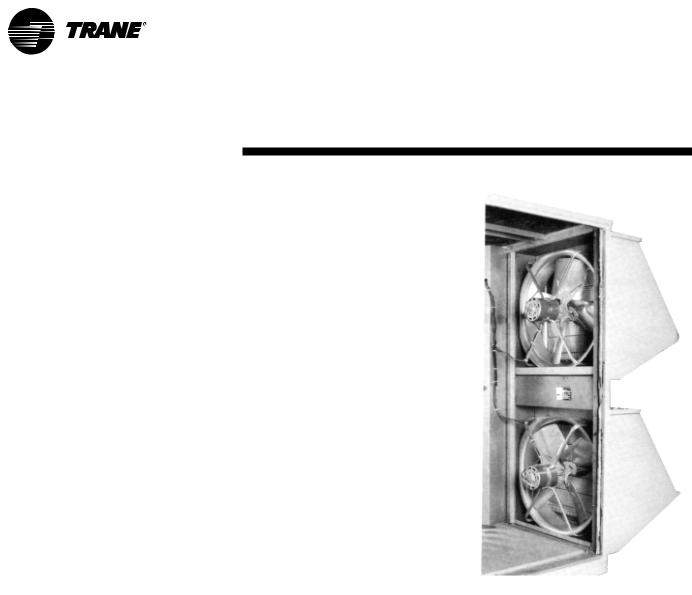
Features and
Benefits
Easy to Service
Because today’s owners are very costconscious when it comes to service and maintenance, theTraneVoyager was designed with direct input from service contractors.This valuable information helped to design a product that would get the serviceman off the job quicker and save the owner money.Voyager does this by offering:
A Simpler Design
TheVoyager design uses fewer parts than previous units. Since it is simpler in design, it is easier to diagnose.
Micro
The Micro requires no special tools to run theVoyager unit through its paces. Simply place a jumper betweenTest 1 andTest 2 terminals on the LowVoltage Terminal Board and the unit will walk through its operational steps automatically.
—The unit automatically returns control to the zone sensor after stepping through the test mode a single time, even if the jumper is left on the unit.
As long as the unit has power and the “system on” LED is lit, the Micro is operational.The light indicates that the Micro is functioning properly.
The Micro features expanded diagnostic capabilities when utilized withTrane’s Integrated Comfort™ Systems.
Some Zone Sensor options have central control panel lights which indicate the mode the unit is in and possible diagnostic information (dirty filters for example).
Easy Access LowVoltageTerminal Board
Voyager’s LowVoltageTerminal Board is external to the electrical control cabinet. It is extremely easy to locate and attach the thermostat wire.This is another cost and time-saving installation feature.
Value
Low Ambient Cooling
AllVoyager Commercial units have cooling capabilities down to 0 F as standard.
Power Exhaust Option
Provides exhaust of the return air when using an economizer to maintain proper building pressurization. Great for relieving most building overpressurization problems.
Micro Benefits
The Micro in theVoyager units has builtin anti-short-cycle timer, time delay relay and minimum “on” time controls.These controls are functions of the Micro and are factory tested to assure proper operation.
The Micro softens electrical “spikes” by staging on fans, compressors and heaters.
Intelligent Fallback is a benefit to the building occupant. If a component goes astray, the unit will continue to operate at predetermined temperature setpoint.
Intelligent Anticipation is a standard feature of the Micro. It functions constantly as the Micro and zone sensor work together in harmony to provide tighter comfort control than conventional electro-mechanical thermostats.
Horizontal Discharge with Power Exhaust Option
8 |
RT-PRC007-EN |
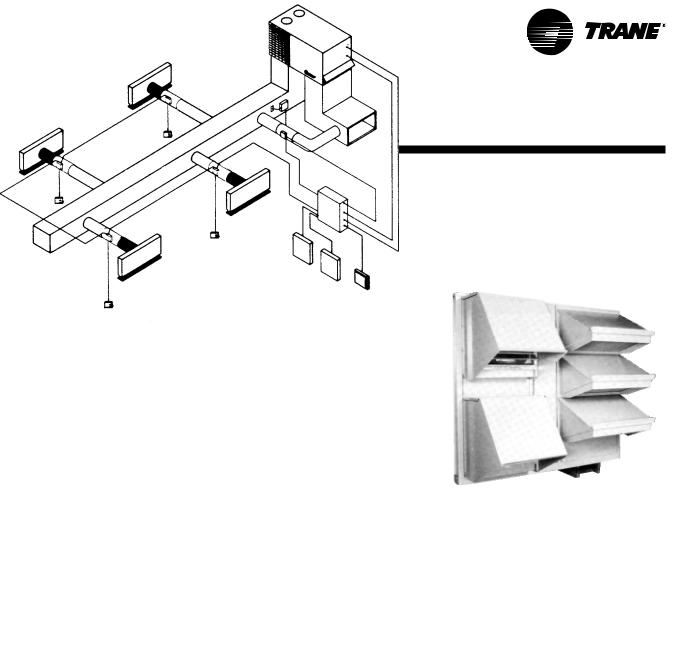
Features and
Benefits
VariTrac
Trane’s changeoverVAV System for light commercial applications is also available. Coupled withVoyager Commercial, it provides the latest in technological advances for comfort management systems and can allow thermostat control in every zone served byVariTrac™.
Central
Control Panel
TIME
CLOCK
INPUT/
STATUS EDIT
PANEL TERMINAL
Downflow and Horizontal Economizers
The economizers come with three control options dry bulb, enthalpy and differential enthalpy. (Photo above shows the three fresh air hoods on the Horizontal Discharge Configuration).
Trane Communication Interface (TCI)
Available factory or field installed.This module when applied with the Micro easily interfaces withTrane’s Integrated Comfort™ System.
Variable Frequency Drives (VFD)
Variable Frequency Drives are factory installed and tested to provide supply fan motor speed modulation.VFD’s, as compared to inlet guide vanes or discharge dampers, are quieter, more efficient, and are eligible for utility rebates.TheVFD’s are available with or without a bypass option. Bypass control will simply provide full nominal airflow in the event of drive failure.
Trane factory built roof curbs
Available for all units.
One of Our Finest Assets
Trane Commercial Sales Engineers are a support group that can assist you with:
—Product
—Application
—Service —Training
—Special Applications
—Specifications
—Computer Programs and more
RT-PRC007-EN |
9 |
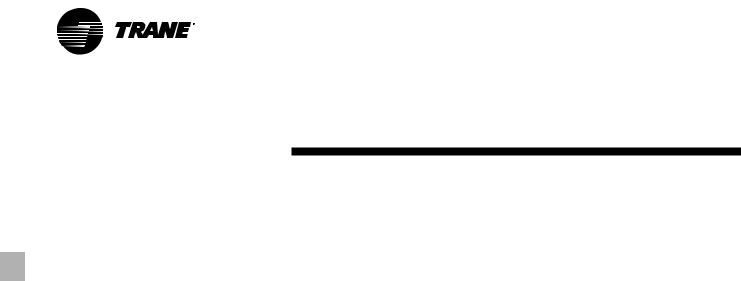
Application
Considerations
Exhaust Air Options
When is it necessary to provide building exhaust?
Whenever an outdoor air economizer is used, a building generally requires an exhaust system.The purpose of the exhaust system is to exhaust the proper amount of air to prevent over or underpressurization of the building.
A building may have all or part of its exhaust system in the rooftop unit. Often, a building provides exhaust external to the air conditioning equipment.This external exhaust must be considered when selecting the rooftop exhaust system.
Voyager Commercial rooftop units offer two types of exhaust systems:
1
Power exhaust fan.
2
Barometric relief dampers.
Application Recommendations
Power Exhaust Fan
The exhaust fan option is a dual, nonmodulating exhaust fan with approximately half the air-moving capabilities of the supply fan system.The experience ofTheTrane Company is that a non-modulating exhaust fan selected for 40 to 50 percent of nominal supply cfm can be applied successfully.
The power exhaust fan generally should not be selected for more than 40 to 50 percent of design supply airflow. Since it is an on/off nonmodulating fan, it does not vary exhaust cfm with the amount of outside air entering the building. Therefore, if selected for more than 40 to 50 percent of supply airflow, the building may become underpressurized when economizer operation is allowing lesser
amounts of outdoor air into the building. If, however, building pressure is not of a critical nature, the non-modulating exhaust fan may be sized for more than 50 percent of design supply airflow. ConsultTable PD-16 for specific exhaust fan capabilities withVoyager Commercial units.
Barometric Relief Dampers
Barometric relief dampers consist of gravity dampers which open with increased building pressure. As the building pressure increases, the pressure in the unit return section also increases, opening the dampers and relieving air. Barometric relief may be used to provide relief for single story buildings with no return ductwork and exhaust requirements less than 25 percent.
Altitude Corrections
The rooftop performance tables and curves of this catalog are based on standard air (.075 lbs/ft). If the rooftop airflow requirements are at other than standard conditions (sea level), an air density correction is needed to project accurate unit performance.
Figure PD-1 shows the air density ratio at various temperatures and elevations. Trane rooftops are designed to operate between 40 and 90 degrees Fahrenheit leaving air temperature.
The procedure to use when selecting a supply or exhaust fan on a rooftop for elevations and temperatures other than standard is as follows:
1
First, determine the air density ratio using Figure PD-1.
2
Divide the static pressure at the nonstandard condition by the air density ratio to obtain the corrected static pressure.
3
Use the actual cfm and the corrected static pressure to determine the fan rpm and bhp from the rooftop performance tables or curves.
4
The fan rpm is correct as selected.
5
Bhp must be multiplied by the air density ratio to obtain the actual operating bhp.
In order to better illustrate this procedure, the following example is used:
Consider a 30-ton rooftop unit that is to deliver 11,000 actual cfm at 1.50 inches total static pressure (tsp), 55 F leaving air temperature, at an elevation of 5,000 ft.
1
From Figure PD-1, the air density ratio is 0.86.
2
Tsp=1.50 inches/0.86=1.74 inches tsp.
3
From the performance tables: a 30-ton rooftop will deliver 11,000 cfm at 1.74 inches tsp at 668 rpm and 6.93 bhp.
4
The rpm is correct as selected — 668 rpm.
5
Bhp = 6.93 x 0.86 = 5.96 .
Compressor MBh, SHR, and kw should be calculated at standard and then converted to actual using the correction factors inTable PD-2. Apply these factors to the capacities selected at standard cfm so as to correct for the reduced mass flow rate across the condenser.
10 |
RT-PRC007-EN |

Application
Considerations
Heat selections other than gas heat will not be affected by altitude. Nominal gas capacity (output) should be multiplied by the factors given inTable PD-3 before calculating the heating supply air temperature.
Acoustical Considerations
Proper placement of rooftops is critical to reducing transmitted sound levels to the building.The ideal time to make provisions to reduce sound transmissions is during the design phase. And the most economical means of avoiding an acoustical problem is to place the rooftop(s) away from acoustically critical areas. If possible, rooftops should not be located directly above areas such as: offices, conference rooms, executive office areas and classrooms. Instead, ideal locations might be over corridors, utility rooms, toilets or other areas where higher sound levels directly below the unit(s) are acceptable.
Several basic guidelines for unit placement should be followed to minimize sound transmission through the building structure:
1
Never cantilever the compressor end of the unit. A structural cross member must support this end of the unit.
2
Locate the unit’s center of gravity which is close to, or over, a column or main support beam.
3
If the roof structure is very light, roof joists must be replaced by a structural shape in the critical areas described above.
4
If several units are to be placed on one span, they should be staggered to reduce deflection over that span.
It is impossible to totally quantify the effect of building structure on sound transmission, since this depends on the response of the roof and building members to the sound and vibration of the unit components. However, the guidelines listed above are experienceproven guidelines which will help reduce sound transmissions.
Clearance Requirements
The recommended clearances identified with unit dimensions should be maintained to assure adequate serviceability, maximum capacity and peak operating efficiency. A reduction in unit clearance could result in condenser coil starvation or warm condenser air recirculation. If the clearances shown are not possible on a particular job, consider the following:
Do the clearances available allow for major service work such as changing compressors or coils?
Do the clearances available allow for proper outside air intake, exhaust air removal and condenser airflow?
If screening around the unit is being used, is there a possibility of air recirculation from the exhaust to the outside air intake or from condenser exhaust to condenser intake?
Actual clearances which appear inadequate should be reviewed with a localTrane sales engineer.
When two or more units are to be placed side by side, the distance between the units should be increased to 150 percent of the recommended single unit clearance.The units should also be staggered for two reasons:
1
To reduce span deflection if more than one unit is placed on a single span. Reducing deflection discourages sound transmission.
2
To assure proper diffusion of exhaust air before contact with the outside air intake of adjacent unit.
Duct Design
It is important to note that the rated capacities of the rooftop can be met only if the rooftop is properly installed in the field. A well designed duct system is essential in meeting these capacities.
The satisfactory distribution of air throughout the system requires that there be an unrestricted and uniform airflow from the rooftop discharge duct. This discharge section should be straight for at least several duct diameters to allow the conversion of fan energy from velocity pressure to static pressure.
However, when job conditions dictate elbows be installed near the rooftop outlet, the loss of capacity and static pressure may be reduced through the use of guide vanes and proper direction of the bend in the elbow.The high velocity side of the rooftop outlet should be directed at the outside radius of the elbow rather than the inside.
RT-PRC007-EN |
11 |
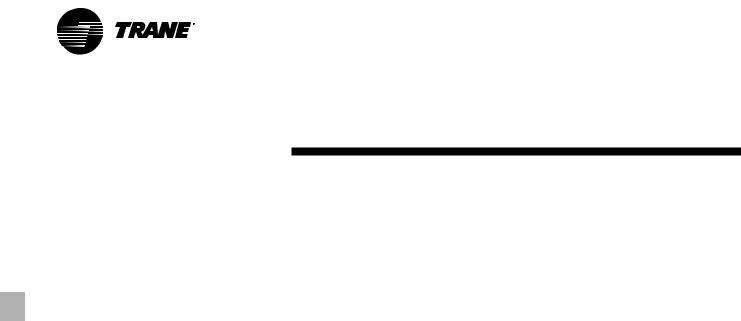
Selection
Procedure
Selection ofTrane commercial air conditioners is divided into five basic areas:
1
Cooling capacity
2
Heating capacity
3
Air delivery
4
Unit electrical requirements
5
Unit designation
Factors Used In Unit Cooling Selection:
1
Summer design conditions — 95 DB/
76WB, 95 F entering air to condenser.
2
Summer room design conditions — 76 DB/66WB.
3
Total peak cooling load — 321 MBh (27.75 tons).
4
Total peak supply cfm — 12,000 cfm.
5
External static pressure — 1.0 inches.
6
Return air temperatures — 80 DB/66WB.
7
Return air cfm — 4250 cfm.
8
Outside air ventilation cfm and load — 1200 cfm and 18.23 MBh (1.52 tons).
9
Unit accessories include:
a
Aluminized heat exchanger — high heat module.
b
2” Hi-efficiency throwaway filters.
c
Exhaust fan.
d
Economizer cycle.
Step 1 — A summation of the peak cooling load and the outside air ventilation load shows: 27.75 tons + 1.52 tons = 29.27 required unit capacity. From Table 18-2, 30-ton unit capacity at 80 DB/ 67WB, 95 F entering the condenser and 12,000 total peak supply cfm, is 30.0 tons. Thus, a nominal 30-ton unit is selected.
Step 2 — Having selected a nominal 30ton unit, the supply fan and exhaust fan motor bhp must be determined.
Supply Air Fan:
Determine unit static pressure at design supply cfm:
External static pressure |
1.20 inches |
Heat exchanger |
.14 inches |
(Table PD-14) |
|
High efficiency filter 2” |
.09 inches |
(Table PD-14) |
|
Economizer |
.076 inches |
(Table PD-14) |
|
Unit total static pressure |
1.50 inches |
Using total cfm of 12,000 and total static pressure of 1.50 inches, enterTable PD-12.Table PD-12 shows 7.27 bhp with 652 rpm.
Step 3 — Determine evaporator coil entering air conditions. Mixed air dry bulb temperature determination.
Using the minimum percent of OA (1,200 cfm ÷ 12,000 cfm = 10 percent), determine the mixture dry bulb to the evaporator. RADB + %OA (OADB - RADB) = 80 + (0.10) (95 - 80) = 80 + 1.5 = 81.5F
Approximate wet bulb mixture temperature:
RAWB + OA (OAWB - RAWB) = 66 + (0.10) (76-66) = 68 + 1 = 67 F.
A psychrometric chart can be used to more accurately determine the mixture temperature to the evaporator coil.
Step 4 — Determine total required unit cooling capacity:
Required capacity = total peak load + O.A. load + supply air fan motor heat.
From Figure SP-1, the supply air fan motor heat for 7.27 bhp = 20.6 MBh.
Capacity = 321 + 18.23 + 20.6 = 359.8 MBh (30 tons)
Step 5 — Determine unit capacity:
FromTable PD-4 unit capacity at 81.5 DB. 67WB entering the evaporator, 12000 supply air cfm, 95 F entering the condenser is 361 MBh (30.1 tons) 279 sensible MBh.
Step 6 — Determine leaving air temperature:
Unit sensible heat capacity, corrected for supply air fan motor heat 279 - 20.6 = 258.4 MBh.
Supply air dry bulb temperature difference = 258.4 MBh ÷ (1.085 x 12,000 cfm) = 19.8 F.
Supply air dry bulb: 81.5 - 19.8 = 61.7.
Unit enthalpy difference = 361 ÷ (4.5 x 12,000) = 6.7
Btu/lb leaving enthalpy = h (entWB) = 31.62
Leaving enthalpy = 31.62 Btu/lb - 6.7 Btu/lb = 24.9 Btu/lb.
FromTable PD-1, the leaving air wet bulb temperature corresponding to an enthalpy of 24.9 Btu/lb = 57.5.
Leaving air temperatures = 61.7 DB/57.5WB
12 |
RT-PRC007-EN |
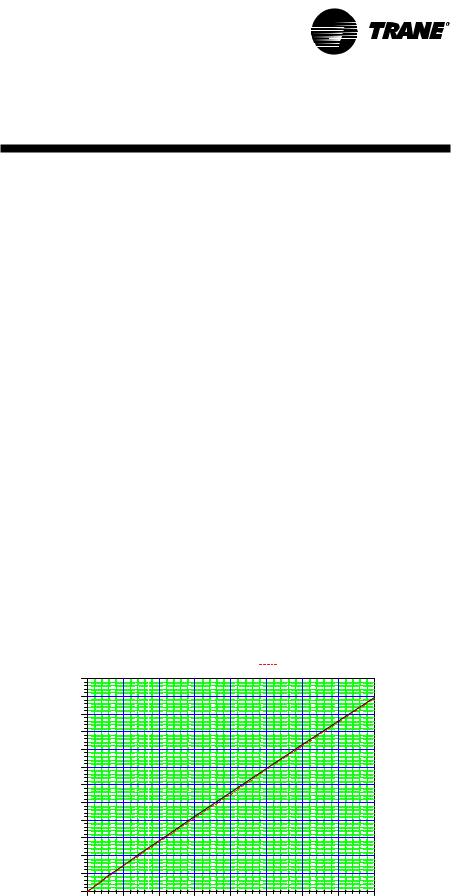
Selection
Procedure
Heating capacity selection:
1
Winter outdoor design conditions—5 F.
2
Total return air temperature — 72 F.
3
Winter outside air minimum ventilation load and cfm — 1,200 cfm and 87.2 MBh.
4
Peak heating load 225 MBh.
Utilizing unit selection in the cooling capacity procedure.
Mixed air temperature = RADB + %O.A. (OADB - RADB) = 72
+ (0.10) (0-72) = 64.8 F.
Supply air fan motor heat temperature rise = 20,600 BTU ÷ (1.085 x 12,000) cfm = 1.6 F.
Mixed air temperature entering heat module = 64.8 + 1.6 = 66.4 F.
Total winter heating load = peak heating + ventilation load - total fan motor heat = 225 + 87.2 - 20.6 = 291.6 MBh.
Electric Heating System
Unit operating on 480/60/3 power supply. FromTable PD-9, kw may be selected for a nominal 30-ton unit operating on 480volt power.The high heat module — 90 KW or 307 MBh will satisfy the winter heating load of 291.6 MBh.
Table PD-9 also shows an air temperature rise of 23.6 F for 12,000 cfm through the 90 kw heat module.
Unit supply temperature at design heating conditions = mixed air temperature + air temperature rise = 66.4 + 23.6 = 90 F.
Natural Gas Heating System
Assume natural gas supply — 1000 Btu/ ft3. FromTable PD-11, select the high heat module (486 MBh output) to satisfy 291.6 at unit cfm.
Table PD-11 also shows air temperature rise of 37.3 F for 12,000 cfm through heating module.
Unit supply temperature design heating conditions = mixed air temperature + air temperature rise = 66.4 + 37.3 = 103.7 F.
Air Delivery Procedure
Supply air fan bhp and rpm selection. Unit supply air fan performance shown inTable PD-12 includes pressure drops for dampers and casing losses. Static pressure drops of accessory components such as heating systems, and filters if used, must be added to external unit static pressure for total static pressure determination.
The supply air fan motor selected in the previous cooling capacity determination example was 7.27 bhp with 652 rpm.
Thus, the supply fan motor selected is 7.5 hp.
To select the drive, enterTable PD-15 for a 30-ton unit. Select the appropriate drive for the applicable rpm range. Drive selection letter C with a range of 650 rpm, is required for 652 rpm.Where altitude is significantly above sea level, useTable PD-2 and PD-3, and Figure PD-1 for applicable correction factors.
Unit Electrical Requirements
Selection procedures for electrical requirements for wire sizing amps, maximum fuse sizing and dual element fuses are given in the electrical service selection of this catalog.
Unit Designation
After determining specific unit characteristics utilizing the selection procedure and additional job information, the complete unit model number can be developed. Use the model number nomenclature on page 14.
Figure SP-1 — Fan Motor Heat |
|
STANDARD MOTOR |
|
||
|
|
HIGH EFFICIENCY MOTOR |
|
120 |
|
|
|
|
|
|
|
|
|
110 |
|
|
|
|
|
|
|
|
MBH |
100 |
|
|
|
|
|
|
|
|
90 |
|
|
|
|
|
|
|
|
|
- |
|
|
|
|
|
|
|
|
|
HEAT |
80 |
|
|
|
|
|
|
|
|
70 |
|
|
|
|
|
|
|
|
|
MOTOR |
60 |
|
|
|
|
|
|
|
|
50 |
|
|
|
|
|
|
|
|
|
|
|
|
|
|
|
|
|
|
|
FAN |
40 |
|
|
|
|
|
|
|
|
30 |
|
|
|
|
|
|
|
|
|
|
|
|
|
|
|
|
|
|
|
|
20 |
|
|
|
|
|
|
|
|
|
10 |
|
|
|
|
|
|
|
|
|
0 |
|
|
|
|
|
|
|
|
|
0 |
5 |
10 |
15 |
20 |
25 |
30 |
35 |
40 |
MOTOR BRAKE HORSE POWER
RT-PRC007-EN |
13 |
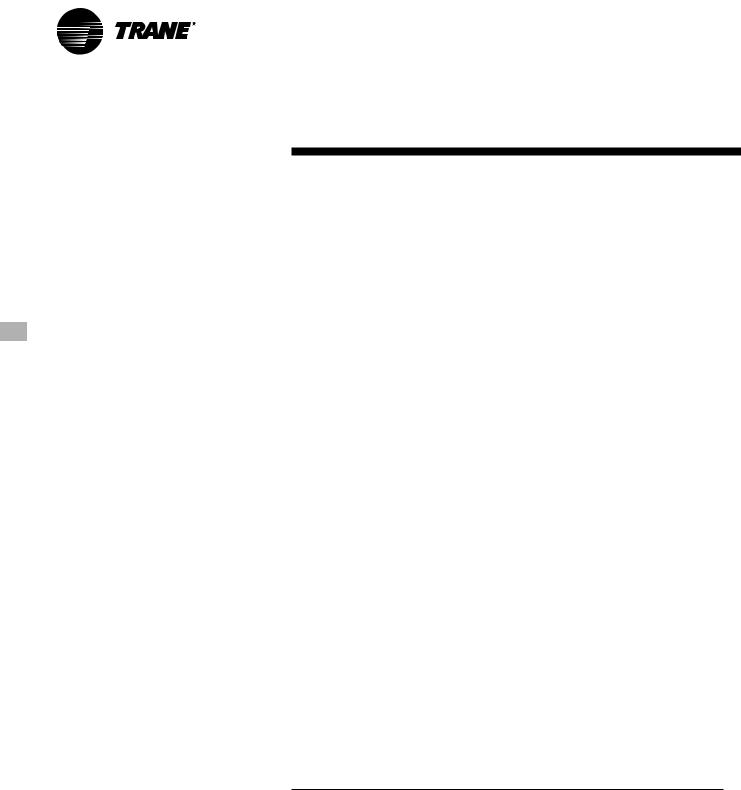
Model
Number
Description
YC |
D |
480 |
A |
4 |
|
H |
|
A |
1 |
|
A |
|
4 |
|
F |
|
D |
1 |
A |
0 |
0 |
0 |
|
0 |
|
0 |
0 |
|
0 |
|
0 |
0 |
0 |
|
0 |
05 |
||||
12 |
3 |
456 |
7 |
|
8 |
|
9 |
|
10 |
|
11 |
|
12 |
13 |
|
14 |
|
15 |
|
16 |
17 |
18 |
19 |
20 |
|
21 |
|
22 |
|
23 |
24 |
25 |
26 |
27 |
|
28 |
29 |
|||
Digit 1, 2 — Unit Function
TC |
= |
DX Cooling, No Heat |
TE |
= |
DX Cooling, Electric Heat |
YC |
= |
DX Cooling, Natural Gas Heat |
Digit 3 — Unit Airflow Design
D = Downflow Configuration
H = Horizontal Configuration
Digit 4, 5, 6 — Nominal Cooling Capacity
330 = 27½ Tons
360 = 30 Tons
420 = 35 Tons
480 = 40 Tons
600 = 50 Tons
Digit 7 — Major Development Sequence
A = First
Digit 8 — Power Supply (See Note 1)
E = 208/60/3
F = 230/60/3 4 = 460/60/3 5 = 575/60/3
Digit 9 — Heating Capacity (See Note 4)
0 = No Heat (TC only) L = Low Heat (YC only) H = High Heat (YC only)
Note: When second digit is “E” for Electric Heat, the following values apply in the ninth digit.
A= 36 KW
B= 54 KW
C= 72 KW
D= 90 KW
E= 108 KW
Digit 10 Design Sequence
A = First
Digit 11 — Exhaust
0 = None
1 = Barometric Relief (Available w/Economizer only) 2 = Power Exhaust Fan (Available w/Economizer only)
Digit 12 — Filter
A = Standard 2” Throwaway Filters
B = High Efficiency 2” Throwaway Filters C = High Efficiency 4” Throwaway Filters
Digit 13 — Supply Fan Motor, HP
1 = 7.5 Hp Std. Eff.
2 = 10 Hp Std. Eff.
3 = 15 Hp Std. Eff.
4 = 20 Hp Std. Eff.
5 = 7.5 Hp Hi. Eff.
6 = 10 Hp Hi. Eff.
7 = 15 Hp Hi. Eff.
8 = 20 Hp Hi. Eff.
Digit 14 — Supply Air Fan Drive Selections (See Note 3)
A = 550 RPM |
H = 500 RPM |
B = 600 RPM |
J = 525 RPM |
C = 650 RPM |
K = 575 RPM |
D = 700 RPM |
L = 625 RPM |
E = 750 RPM |
M = 675 RPM |
F = 790 RPM |
N = 725 RPM |
G = 800 RPM |
|
Digit 15 — Fresh Air Selection
A= No Fresh Air
B= 0-25% Manual Damper
C= 0-100% Economizer, Dry Bulb Control
D= 0-100% Economizer, Reference Enthalpy Control
E= 0-100% Economizer, Differential Enthalpy Control
F= “C” Option and Low Leak Fresh
Air Damper
G= “D” Option and Low Leak Fresh Air Damper
H= “E” Option and Low Leak Fresh Air Damper
Digit 16 — System Control
1 = Constant Volume
2 = VAV Supply Air Temperature Control w/o Inlet Guide Vanes
3 = VAV Supply Air Temperature Control w/Inlet Guide Vanes
4 = VAV Supply Air Temperature Control w/Variable Frequency Drive w/o Bypass
5 = VAV Supply Air Temperature Control w/Variable Frequency Drive and Bypass
Note: Zone sensors are not included with option and must be ordered as a separate accessory.
Digit 17 - 29 — Miscellaneous
A= Service Valves (See Note 2)
B= Through the Base Electrical Provision
C= Non-Fused Disconnect Switch with External Handle
D= Factory-Powered 15A GFI Convenience Outlet and Non-Fused Disconnect Switch with
External Handle
E= Field-Powered 15A GFI Convenience Outlet
F= ICS Control Option — Trane Communication Interface, Supply Air Sensing and Clogged Filter Switch
G= Ventilation Override
H= Hinged Service Access
J= Condenser Coil Guards
K= LonTalk Communication Interface
L= Special
M= Stainless Steel Drain Pans
N= Black Epoxy Coated Condenser Coil
Note:
1.All voltages are across the line starting only.
2.Option includes Liquid, Discharge, Suction Valves.
3.Supply air fan drives A thru G are used with 27½-35 ton units only and drives H thru N are used with 40 & 50 ton units only.
4.Electric Heat KW ratings are based upon voltage ratings of 240/480/600 V. Voltage offerings are as follows (see table PD-9 for additional information):
|
|
|
|
KW |
|
|
Tons |
Voltage |
36 |
54 |
72 |
90 |
108 |
27½ to 35 |
240 |
x |
x |
|
|
|
|
480 |
x |
x |
x |
x |
|
|
600 |
|
x |
x |
x |
|
40 and 50 |
240 |
|
x |
|
|
|
|
480 |
|
x |
x |
x |
x |
|
600 |
|
x |
x |
x |
x |
5. The service digit for each model number contains 29 digits; all 29 digits must be referenced.
14 |
RT-PRC007-EN |
